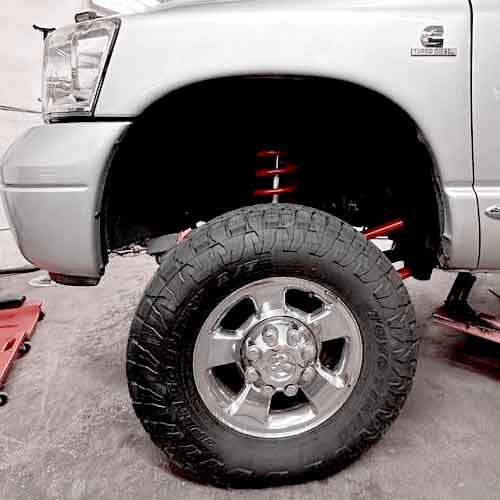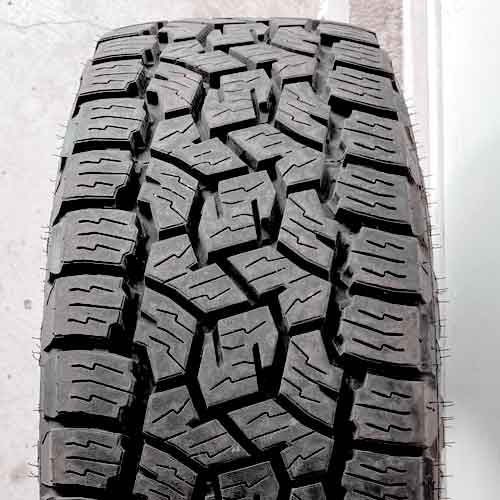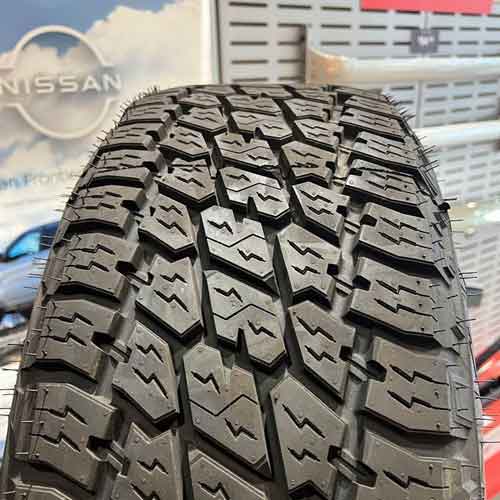Nitto and Toyo are both manufacturers of these all-terrain tires and although the work under they same hood (sister companies), they offer different approach on both. The Toyo AT3 is a general-purpose tire that can handle a wide range of situations, while the Nitto Terra Grappler G2 is geared towards drivers who prioritize on-road performance.

As a tire engineer, from my perspective, the Toyo Open Country AT3 is better on almost all off road sections, and on road, it’s better in fuel, comfort, and wet traction. Terra Grappler on the other side, has very similar dry highway traction, but its wet gripping needs a lot of helping, that’s because its sipes are better optimized for snow, but it still cant outperform Toyo AT3 there as well, despite having 3pmsf rating like it.
Tire Sizes
Speaking of Nitto Terra Grappler first it comes in 17 to 24 inches with following specs.
- Speed ratings: R, S, T and H.
- Load Ratings: SL, XL, D, E, and F.
- Weight Range: 30 to 80 pounds.
- Tread Depth Range: 12 to 17/32 inches.
Read detailed review of the tire here.
Toyo AT3 on the other hand comes in 15 to 22 inches, having more number of sizes, and they have following specs.
- Load ratings available: C to F.
- Speed ratings available: Q, R, S, T and H.
- Weight range: 30 lbs to 72 lbs.
- Tread depth range: 12.7/32″ to 17/32″ (very similar range is offered).
Both tires have similar warranties of 65k miles for P metric sizes, and 50k for LT, and both give you 3PMSF & M+S ratings.
Durability
All-terrain tires are made tough through their internal construction and the composition of the rubber outside.
And although both of these tires feature cut/chip resistant rubber, their internal built vary a little.
Nitto Terra Grappler G2 offers 2 ply polyester casing with 2 steel belts and 2 cap plies of nylon.
And in comparison, the Toyo Open Country AT3 although also offers 2 ply casing and 2 layers of steel belts, its only topped with just a single cap ply.
So both tires have similar sidewalls durability, but you can say Nitto Terra has slightly stronger overall make-up.
- Detailed Review of Nitto Terra Grappler: https://tiredriver.com/nitto-terra-grappler-g2-all-terrain-review/
- Detailed Review of Toyo AT3: https://tiredriver.com/toyo-open-country-at3-review/
Tread Design
Starting with a more aggressive looking tire in comparison, the Toyo AT3.

It features a design with S-shaped lugs in the center, surrounded by F-shaped ones.
They are all arranged in a way which yields a solid grip from all sides, thanks to their notches that face both laterally and longitudinally.
All these lugs have interlocking full depth sipes and reinforced foundations, which contribute to the tire’s stability on the road, enhancing directional traction.
And for lateral traction, it offers shoulder lugs, which are although divided by wider circumferential channels, have ridges placed in between.
With these ridges/connectors, the tire still gets to have an enhanced handling grip as well.
Basically the shoulder rib has a secondary continuous layer of rubber running underneath, and all the lugs sit on top, so they form a solid grip with the ground, allowing this tire to reach up to H, in speed ratings.
(Almost similar thing is going on in Nitto Terra, as I’ll explain below).
Furthermore, Toyo AT3 forms staggered shoulder lugs with bigger mud scoops in comparison, though its sidewall lugs could have gotten better.
On the other side, the Nitto Terra Grappler offers a more on road oriented design with 5 conventional ribs.

The outer ribs contain staggered shoulder lugs which extend to the sidewalls and make dual sidewall design (different pattern on each side).
(These lugs have notches and stone ledges connecting the facing ribs).
Moreover, all these shoulder lugs are joined together by a secondary rubber layer running underneath them just like Toyo AT3.
And the middle most rib is made wider so that it can make more rubber to road contact for superior braking and acceleration traction.
These are also equipped with notches, chamfered edges and “4” shaped siping (which can be seen all over the tread).
Though, one thing to consider, that the sipes only have this shape on the outside, meaning they may look interlocking here, but as the tire wear, you get to know they are just rectilinear from underneath, that’s why its wet grip is good enough.
On-Road Noise
With closed up shoulder lugs on both tires, although very less air comes through, and hit the grooves to generate unwanted sound pollution, the Toyo Open Country AT3 is still a more silent-on-road pick.
That’s because it’s ridges in between allow a better air flow (neither too restrictive/nor too open), and it’s grooves in the middle are more streamlined.
So this combined with pitch sequencing very less on road noise is heard.
Pitch sequencing is basically variation of tread lugs’ geometry, so air hitting them can generate different sound frequencies and can cancel out each other.
Nitto Terra Grappler although also offers this, and names it as the “variable pitch technology”, its still louder in comparison, because of it’s less streamlined tread, which produces larger groove resonance.
Highway Performance
To evaluate the dry performance of these all-terrain tires, I considered several factors, including traction, steering and cornering abilities.
Traction refers to the tire’s ability to accelerate and brake effectively, while steering refers to how well the tire responds to steering inputs and provides feedback, and here lateral traction tell you the most about the tire’s cornering abilities.
Let’s check them all out one by one.
Dry Grip
While all-terrain tires are expected to meet a certain standard of traction, this is typically not too challenging, that’s because they have enough biters to grab the surface, and their tread is not too overly voided, allowing them to make a decent meet-up with the road.
Speaking of which, out of both tires, the Toyo AT3 shows better efficacy, with shorter braking distances. This is because it has more optimized central tread, offering more rubber to road contact comparatively.
Though the difference is very low. I am talking about less than a feet longer braking distance on Nitto Terra Grappler.
Lateral Traction
Handling is similar to grip, but refers specifically to the tire’s performance when turning.
When a tire turns, the weight is shifted towards the shoulders, so these lugs are the most responsible for handling times (by maintaining contact with the road).
Although both tires have similar shoulder design, with foundational supports underneath, the Toyo AT3 still offers better lateral traction with it’s more rubber availability there.
Basically, it’s shoulder lugs don’t have any traction notches (unlike the Terra Grappler), which eat away the rubber contact with the road.
Steering Response
The continuity of sideways section is crucial for rapid steering response, but this can be difficult to achieve with all-terrain tires, though both these tires are slightly better, as they are more aligned towards performing on highways, as both offer speed ratings up to H.
Still out of them, with slightly lighter weight, the Toyo AT3 produces better outputs.
Wet Traction
The overall wet performance of a tire is a combination of wet traction and hydroplaning resistance, both of which are important for effectively removing water from beneath the tire.
Wet Grip
On wet roads, sipes play a crucial role in helping to clear water from the surface of the tire. These sipes work by soaking up and wiping away the water as the tire moves.
The Nitto Terra Grappler although offers a lot of sipes all over the tread, they are not effective, that’s because they are better optimized for snow.
It’s sipes basically are thicker, not that flexible, and form smaller slits, so they are not able to suck in water that effectively.
The Toyo Open Country AT3, on the other hand, is although not so great overall, it still renders better traction values with it’s interlocking siping pattern.
Aquaplaning
Hydroplaning resistance is crucial in preventing a tire from losing contact with the road (as layer of water comes in between). This can be achieved through a tread design that features circumferential grooves and open shoulder blocks to help channel water away and out.
Both tires offer good enough hydroplaning resistance but only on straight roads, as with closed up shoulder lugs, they can’t evacuate water out sideways.
That’s because both of them have shoulder lugs sitting on a continuous running ribs underneath.
Though, with interconnected grooves offering in Toyo AT3, it’s able to still yield better results if you look at the overall picture.
Fuel and Tread Consumption
Here the main thing to consider is rolling resistance, and contributing it are the weight, tread depth, composition, and the overall tread structure.
Now although tread depth is similar on both tires, the Toyo AT3 being a lighter option produces less rolling friction.
That’s why it does better in terms of fuel.
Though both tires are equally good in terms of tread wear, and you can’t really put one over the other, that’s why, both of them also come up with similar tread wear warranties on LT and P metric sizes.
Winter Traction
The key elements of winter traction includes the tire’s ability to maintain forward momentum, cornering capability, and braking response on a variety of snowy surfaces.
Now as far as the forward momentum is concerned, both tires with 3 peak mountain snowflake ratings show their capability (as that symbol is only given to tires with enhanced acceleration capabilities).
But on other areas, the Toyo AT3 shows better results because of its enhanced snow grabbing ability.
The notches on the S and F shaped lugs are efficient in trapping the snow flakes and make a superior snow to snow contact, producing needed traction (snowflakes stick better on each other due to their interlocking design, so this is preferred here).
Nitto Terra Grappler on the other side, is also good enough on light snow filled roads, as it’s sipes are better optimized for it (where it lacked severely on wet roads).
Off Road Performance
Some off-road terrains, like mud, can be particularly challenging while others, like gravel and dirt filled roads, may be more suitable for on-road oriented tires. Let’s check out all of these terrains.
Muddy Terrains
Packed tread blocks are not effective for driving on muddy surfaces. So it can be seen why both tires with such closed up shoulder lugs have a hard time escaping mud (especially sideways).
Though still out of these tires, the Nitto Terra Grappler offers better mud cleaning and hence traction.
That’s because one, its ribs don’t make an interlocking design, like the Toyo AT3 where mud gets trapped way more easily. And two, its shoulder lugs are not aggressively packed with ridges placements, meaning there is still gap for little bit of mud to leave out.
On Rocks
On rocks you need durability and biters. And comparing these tires, although you are not going to like the durability factor on both, the biting ability of Toyo Open Country AT3 is more more appreciative.
The Nitto Terra Grappler has a more on road oriented design and with that, it only offers a decent directional grip, and lacks gripping force in other angles.
Though it does perform better with lowered air pressure.
Soft Sand
Tires with a softer composition and thicker sidewalls act as “scoops” to help push sand backwards for forward momentum.
And here, although it seems both tires have similar traction scoops on sides, the ones on Toyo AT3 are smoother, so they don’t want to dig in to the sand. So this way, a better forward moving inertia is achieved.
Furthermore, the tire is also lighter in weight, so it puts less pressure on it’s lugs and offers better incline traction, whereas the opposite is happening on Nitto Terra Grappler.
On Dirt Filled Roads
On dirt filled tracks, you need cut resistant rubber and stone ejectors.
Both tires although offer chip resistant rubber, they don’t have what one would call, conventional stone ejectors, though still Toyo AT3 is one of the top performing tires here (in the list of less aggressive A/Ts).
This is because the ridges in between the shoulder lugs actually act as dirt ejectors as well, and they don’t allow any sharp stone to get lodged in especially during cornering.
It’s central section is also better voided and dirt leaves out much more easily form there as well.
On the other side, the Nitto Terra Grappler lacks as it’s stiffer lugs invite more sharp particles to settle in, and they not only try to damage it, also limits the grip.
To Conclude
Nitto Terra Grappler G2 is a nice budget pick, but it’s lacks on a lot more performance section in comparison.
Though you can say, it does good off road on muddy terrains, and it’s traction on snow is almost on par here.
Toyo Open Country AT3, conversely, offers superior rocky terrain, sand, and gravely roads traction, it’s better on roads overall, in terms of noise, fuel usage, and even wet traction, though it’s not that impressive compared to other all-terrain tires. Check them all here.